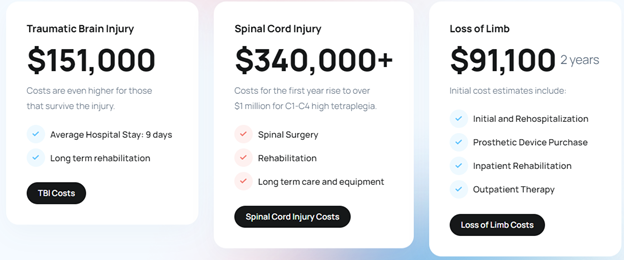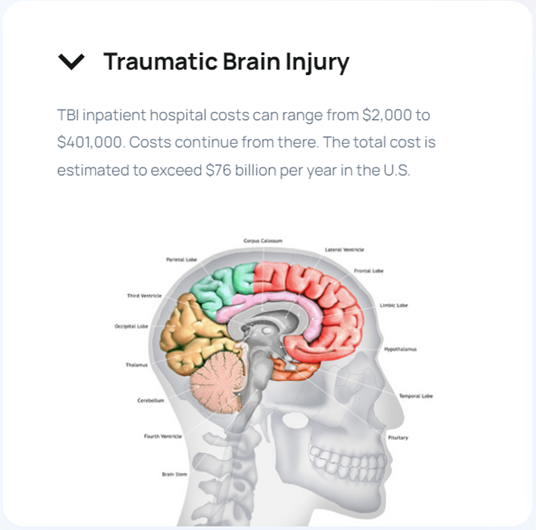Media
The Cost of a Serious Injury
Serious injuries bring more than immediate physical and emotional distress, they also lead to financial challenges that can last a lifetime. The initial impact is felt through substantial medical bills for immediate treatment and ongoing healthcare needs, often compounded by the loss of income if the injured individual is unable to return to work for an extended period, if at all. The situation becomes even more challenging when considering long-term implications such as the need for rehabilitation, home modifications, and continuous medical care.
Non-economic costs like emotional and psychological support further add to financial burdens. The injured person and their family might require counseling and other mental health services to cope with the trauma and temporary or permanent changes to their life and lifestyle. For families, this scenario creates a pressing need to secure financial stability, not just for the immediate expenses but also for unforeseen costs that will arise over time.
In such circumstances, seeking legal counsel becomes crucial. An experienced attorney can play a pivotal role in navigating the complex process of claiming compensation. They can assist in recovering lost wages, securing funds for ongoing medical treatment, and ensuring that the injured party receives adequate compensation to cover both current and future expenses related to the injury. Legal representation thus becomes an essential support system, advocating for the rights of the injured and providing a pathway to financial relief and stability in the wake of a life-altering event.
For more information on the costs of a serious injury, read below. To contact an attorney at Schneider Wallace Cottrell Konecky for a free legal consultation, reach out of us here or by calling 1-800-689-0024, or email at info@schneiderwallace.com.
Traumatic Brain Injury
Traumatic brain injury (TBI) survivors often endure ongoing health challenges and lifestyle changes, necessitating various types of daily support and care. Key findings from the CDC for individuals five years after serious brain injury:
- 57% experience moderate to severe disability.
- 55% are unemployed, despite being employed before injury.
- 50% require rehospitalization at least once.
- 33% need daily assistance from others.
- 12% live in nursing homes or similar facilities.
The impact of TBI extends beyond medical bills:
- Over half lose their ability to work, affecting their career progression.
- Many face reduced work capacity or require family care due to disability.
Given the high number of TBIs requiring hospitalization annually and initial treatment costs exceeding $400,000, it’s clear why the overall financial burden of TBI runs into tens of billions each year.
Spinal Cord Injury
Every year, around 17,000 Americans endure spinal cord injuries, facing immense costs that span from immediate hospitalization to lifelong care. These expenses include:
- Initial medical treatment and rehabilitation.
- Necessary equipment such as wheelchairs.
- Long-term care and continuous physical rehabilitation.
- Compensation for lost wages and income.
Given that medical expenses alone can reach millions per survivor, financial recovery is crucial to protect the quality of life of individuals and families. Specifically, spinal cord injury-related expenses for the first year can range from $500,000 to $1,000,000, with annual medical costs thereafter up to $185,000. Costs differ from patient to patient, influenced by neurological impairment and other factors.
Key Medical Care Costs Include:
-
- Doctor Visits.
- Occupational Therapy.
- Nursing Home or In-Home Care.
- Prescription Medications.
- Equipment like Wheelchairs.
- Home Modifications.
- Physical and Speech Rehabilitation.
- Mental Health Counseling. Initial Hospitalization.
Post-hospitalization, spinal cord injury survivors often face new expenses such as specialized equipment, home modifications, and long-term rehabilitation. Unforeseen costs, like extensive travel to specialists and emerging health issues due to altered mobility, can also arise.
Importantly, mental health support is crucial for those with spinal cord injuries, aiding in the adjustment to life with a permanent injury. This holistic approach, addressing both mental and physical health, is vital in the recovery and adaptation process.
Loss of Limb
John Hopkins’ analysis reveals that the lifetime cost of a typical amputation, as of 2007, surpasses $500,000. Adjusted for inflation to 2023, this amount exceeds $700,000. Amputation often leads to challenges in maintaining regular income, adding to the overall financial impact. With numerous amputations and related hospitalizations annually, average costs for initial hospital care and short-term treatment can reach above $90,000, though many face significantly higher bills. Consequently, the annual medical cost is estimated at nearly $10 billion.
A 2009 National Inpatient Sample (NIS) study highlighted that U.S. amputation costs exceed eight billion dollars. A 2010 study indicated that lifetime costs for reconstructive surgery average $163,000, while costs for non-reconstructable limbs rise to $509,000. The first two years post-amputation incur an average cost of $91,100 while prosthetic costs for lower limb loss were $182,000.
Post-hospitalization, patients often face new expenses like prosthetics, home modifications, and long-term rehabilitation. Cost categories post-Amputation:
- Initial Hospitalization.
- Doctor Fees.
- Occupational Therapy.
- Nursing Home Care.
- Prescription Medications.
- Prosthetics and Equipment.
- Home Modifications.
- Physical Rehabilitation.
Therapeutic care, both physical and mental, significantly improves long-term patient outcomes. Recovery, particularly from work-related injuries or accidents, involves securing financial resources for all needed treatment.
Amputees often report a lower quality of life due to the injury, loss, and consequent functional limitations. Economic barriers often prevent access to healthcare, therapy, and training needed for functional restoration. Beyond medical expenses, many amputees face reduced work capacity or complete inability to work. Some become disabled or need family care. These broader impacts should be factored into the true costs of amputation.
What if the accident happened on the job?
An injury on the job can offer multiple sources of recovery. One is workers’ compensation benefits. You should speak with a lawyer to determine if there are additional responsible parties, such as a job site with multiple contractor companies. There may be more ways a lawyer can recovery for your injury and loss.
Personal Injury Attorneys
Schneider Wallace is known for our aggressive pursuit of injured patients’ rights through complex litigation and class action lawsuits. To learn more about recovering damages for injuries, schedule a consultation with our trial lawyers at our California, Texas or Puerto Rico office. We practice before state and federal courts in jurisdictions throughout the United States in individual claims, class actions and multidistrict litigation.
To schedule an appointment with our knowledgeable attorneys regarding your or a family members serious injury, please call us for a free consultation at 1-800-689-0024. Or you can email us at info@schneiderwallace.com.



